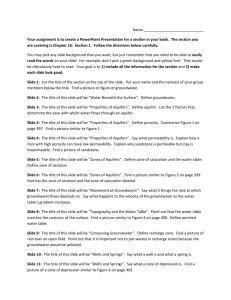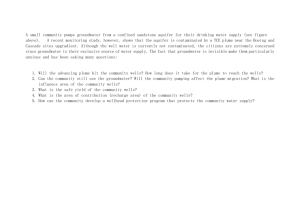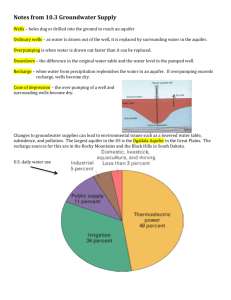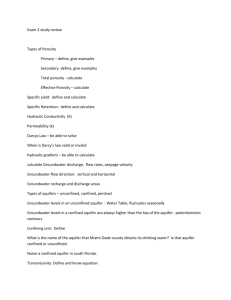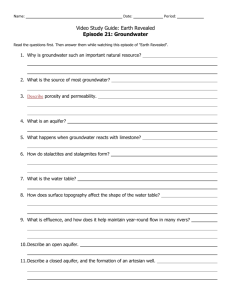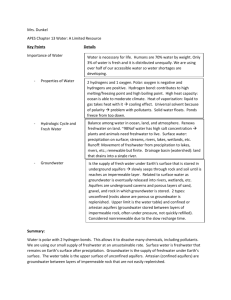10.1-10.3-homeowrk
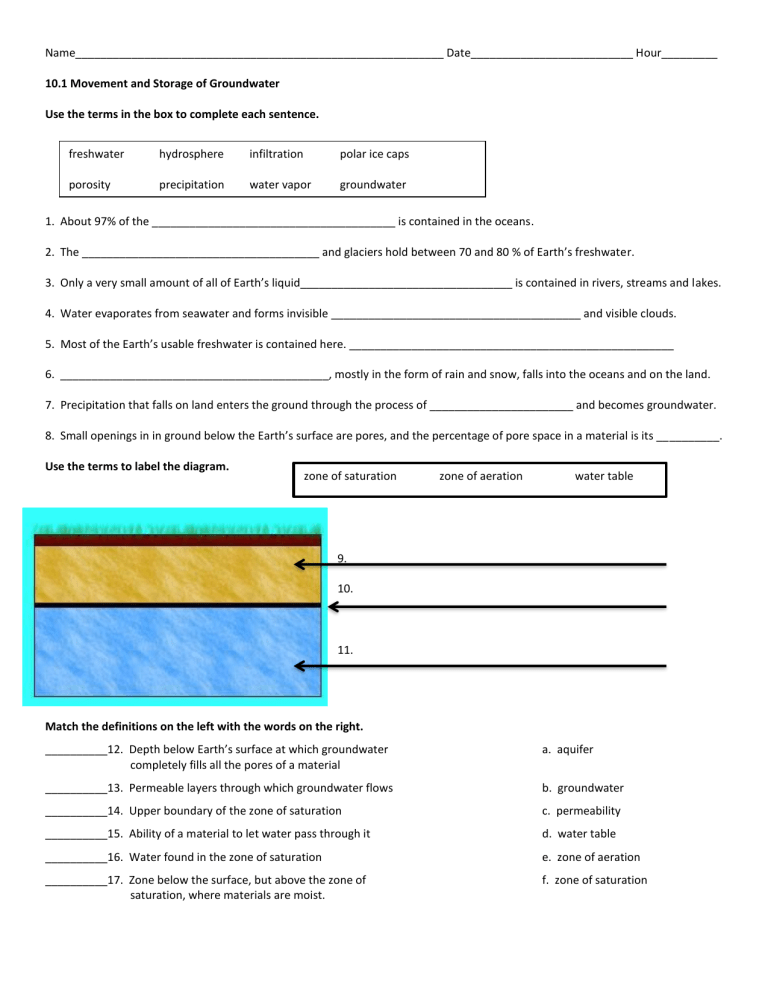
Name___________________________________________________________ Date__________________________ Hour_________
10.1 Movement and Storage of Groundwater
Use the terms in the box to complete each sentence. freshwater hydrosphere infiltration polar ice caps porosity precipitation water vapor groundwater
1. About 97% of the _______________________________________ is contained in the oceans.
2. The ______________________________________ and glaciers hold between 70 and 80 % of Earth’s freshwater.
3. Only a very small amount of all of Earth’s liquid__________________________________ is contained in rivers, streams and lakes.
4. Water evaporates from seawater and forms invisible ________________________________________ and visible clouds.
5. Most of the Earth’s usable freshwater is contained here. ____________________________________________________
6. ___________________________________________, mostly in the form of rain and snow, falls into the oceans and on the land.
7. Precipitation that falls on land enters the ground through the process of _______________________ and becomes groundwater.
8. Small openings in in ground below the Earth’s surface are pores, and the percentage of pore space in a material is its __________.
Use the terms to label the diagram. zone of saturation zone of aeration water table
9.
10.
11.
Match the definitions on the left with the words on the right.
__________12. Depth below Earth’s surface at which groundwater
completely fills all the pores of a material a. aquifer
__________13. Permeable layers through which groundwater flows
__________14. Upper boundary of the zone of saturation b. groundwater c. permeability
__________15. Ability of a material to let water pass through it
__________16. Water found in the zone of saturation
__________17. Zone below the surface, but above the zone of
saturation, where materials are moist. d. water table e. zone of aeration f. zone of saturation
Name___________________________________________________________ Date__________________________ Hour_________
10.3 Groundwater Supply
Use each of the terms in the box just once to complete the passage. artesian well drawdown recharge well
To obtain water, a(n) 1.) ____________________________________ must tap into an aquifer. The difference between the original water-table level and the water level in the pumped well is called the 2)___________________________________________. In order for the water supply of the wells to be replenished, water from precipitation and run-off must 3) ________________________ the zone of saturation. A(n) 4) _________________________________________ contains water that is under pressure, which may cause the well water to spurt into the air.
Write true or false for each statement.
________________5. To produce water, a well must be drilled deep into aquicludes.
________________6. It is very difficult to cause drawdown in an aquifer, no matter how many wells are tapped into the aquifer.
________________7. An important artesian aquifer in the United States in the Ogallala Aquifer.
________________8. Groundwater recharge is faster during periods of heavy precipitation.
________________9. Wells which contain pressurized water are called ordinary wells.
_______________10. Confined aquifers cannot become polluted.
_______________11. Water in an aquifer with high porosity and high permeability flows faster than in an aquifer with low porosity
and low permeability.
_______________12. Overpumping of groundwater can form a cone of depression around a well.
_______________13. If the water table drops, shallow wells can go dry.
Answer the following questions.
14. What are four common sources of groundwater pollution? ________________________________________________________
____________________________________________________________________________________________________________
15. What are two natural pollutants? ____________________________________________________________________________
____________________________________________________________________________________________________________
16. How can salt get into freshwater supplies? _____________________________________________________________________
____________________________________________________________________________________________________________
17. Where does radon originate? ________________________________________________________________________________
____________________________________________________________________________________________________________
18. What is subsidence and what causes it? _______________________________________________________________________
____________________________________________________________________________________________________________
True or False
____________19. Most pollution plumes spread extremely slow, and time is available for alternate water supplies to be found.
___________ 20. Most chemical contaminates can be removed easily from the groundwater aquifers.





